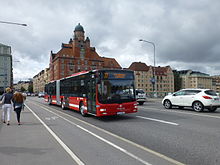
Roslagsbanan is a narrow gauge commuter railway system in Roslagen, Stockholm County, Sweden. Its combined route length is 65 kilometres and there are 38 stations. It is built to the Swedish three foot gauge. The Storstockholms Lokaltrafik (SL) classifies it as "light rail" in its maps.

Nockebybanan is a tram line between Nockeby and Alvik in the western suburbs of Stockholm, Sweden. The 5.6 kilometers (3.5 mi) long line is part of the Storstockholms Lokaltrafik public transport network, and connects with the Stockholm metro and Tvärbanan tram at Alvik metro station. The Nockebybanan, also known as line 12, is operated by Arriva.
Stockholm commuter rail is the commuter rail system in Stockholm County, Sweden. The system is an important part of the public transport in Stockholm, and is controlled by Storstockholms Lokaltrafik. The tracks are state-owned and administered by the Swedish Transport Administration, while the operation of the Stockholm commuter rail services itself has been contracted to MTR Nordic since December 2016.

Transport in Stockholm consists of roads, buses, metro, commuter rail, Inter-city rail, regional rail, light rail, tram, commuter ferry and an archipelago boat operation in Stockholm County, Sweden. The bus and rail is organized by Storstockholms Lokaltrafik, SL, which is owned by the Stockholm County Council. Tickets for all SL services can be purchased most easily in the SL app. For single tickets, just tap a credit card against the turnstiles and on buses. A single ticket is valid for 75 minutes, costs 39 SEK in 2023. The operation and maintenance of the public transport systems are delegated by SL to several contractors. The archipelago boat traffic is handled by Waxholmsbolaget.

Lidingöbanan is a light-rail line in Stockholm, Sweden, between Ropsten and Gåshaga brygga, serving the southern half of Lidingö island.

Djurgårdslinjen is a heritage tram line with the route number 7N, running between Norrmalmstorg and Waldemarsudde in Stockholm, Sweden.

AB Stockholms Spårvägar is a name used by two different Swedish limited companies operating public transport in Stockholm, the capital city of Sweden.

The Arlanda Line is a 19-kilometre (12 mi) long railway line which allows trains on the East Coast Line to reach Stockholm Arlanda Airport in Sigtuna Municipality, Sweden. The Arlanda Line branches from the East Coast Line at Rosersberg and rejoins again at Myrbacken. It is built for speeds of 200 kilometres per hour (120 mph), is electrified at 15 kV 16.7 Hz AC and is double track. The 5-kilometre (3.1 mi) section under the airport runs in a tunnel, and has three stations: Arlanda South, Arlanda Central and Arlanda North.

Kollektivtrafikförvaltningen UL is the integrated transport authority responsible for public transport buses and trains at the county level in Uppsala County, Sweden. Their name is derived from the historical province of Uppland, which included the modern county along with part of what is now Stockholm County.
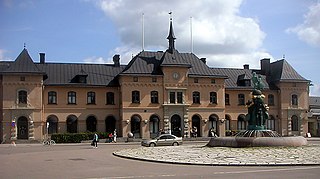
Uppsala Central Station is a railway station in Uppsala, Sweden. It lies on the East Coast Line, which runs south to Stockholm and north to Gävle and Sundsvall. It is also the southeastern terminus for the Dala Line which runs northwest ending in Mora. There are frequent commuter services to Stockholm. Long-distance trains, such as the SJ 3000, connect Uppsala to the northern parts of the country. Many trains, including the Stockholm commuter rail (Pendeltåg), also leave the main line to connect Uppsala with Stockholm-Arlanda Airport. Next to the station is a hub for the regional coach services operated by Upplands Lokaltrafik. Many local bus routes run through or near the station grounds as well, and there is a large area set aside for bicycle parking.

Odenplan station is a station on both the Green Line of the Stockholm Metro and the City Line of the Pendeltåg commuter rail network. It is located at Odenplan in Vasastaden, in Stockholm city centre.
Integrated ticketing allows a person to make a journey that involves transfers within or between different transport modes with a single ticket that is valid for the complete journey, modes being buses, trains, subways, ferries, etc. The purpose of integrated ticketing is to encourage people to use public transport by simplifying switching between transport modes and by increasing the efficiency of the services.

The Djurgården ferry is an inner city ferry route in Stockholm, Sweden. It runs from a terminal near Slussen, in the old town of Gamla Stan, to Allmänna gränd on the island of Djurgården, with an optional stop at the island of Skeppsholmen. The service is integrated into Stockholm's public transport system, as route 82, and accepts all the relevant tickets of Storstockholms Lokaltrafik (SL). It is operated on behalf of SL by Waxholmsbolaget and its sub-contractors, Djurgårdens Färjetrafik.
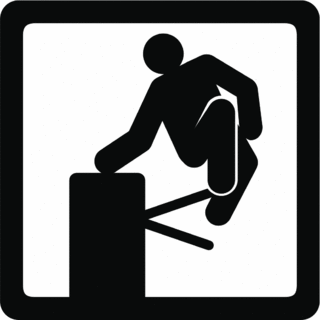
Planka.nu is a network of organizations in Sweden promoting tax-financed zero-fare public transport with chapters in Stockholm, Gothenburg, Skåne and Östergötland. Planka.nu was founded in 2001 by the Swedish Anarcho-syndicalist Youth Federation in response to the increasingly expensive ticket prices in the public transport system in Stockholm. The campaign has received much attention because of the controversial methods used to promote free public transport: Planka.nu encourage people to fare-dodge in the public transport, aiding its members in paying penalty fares through the insurance fund p-kassan.
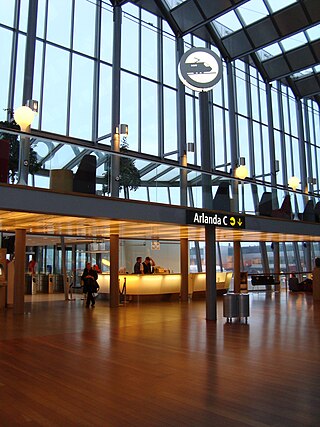
Arlanda Central Station or Arlanda C is a railway station on the Arlanda Line serving Stockholm-Arlanda Airport in Sweden. It is served by regional, intercity, and night trains operated by SJ, and since December 2012 also by Stockholm commuter rail. Upptåget, which used to operate a commuter service between Upplands Väsby and Uppsala via Arlanda C, now only runs a few morning and night trains on weekends.

Farsta Strand is a railway station on the Stockholm commuter rail's Nynäshamn line. It is connected to the Farsta strand metro station, the southern terminus for line 18. The station was originally named "Södertörns villastad". It was renamed "Farsta strand" in 1989.

Bålsta is a railway station located in Bålsta in Håbo municipality, Uppsala County, Sweden. It is located 45.3 km from Stockholm Central Station on the Mälaren Line. The station serves long-distance and regional SJ trains, and is also the north-west terminus for Stockholm's commuter trains, despite being located just outside of Stockholm County.

Ösmo station is a railway station on the Nynäs Line of Stockholm's commuter rail network, located in the urban area of Ösmo in the municipality of Nynäshamn in Stockholm County. As of 2019, on a normal winter weekday, the station has approximately 1,300 boarding passengers. The station is located on the single-track Hemfosa-Nynäshamn section of the line, and lacks ticket barriers. The journey time from Ösmo to Stockholm City Station is approximately 45 minutes.
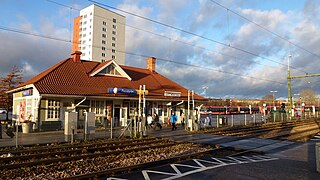
Märsta is a railway station located in Märsta in Sigtuna Municipality, Stockholm County, Sweden. The station is located 36.5km north of Stockholm C, on the Swedish East Coast Line. The station serves long-distance and regional SJ trains, and since 1968 has also been a northern terminus for Stockholm's commuter trains. The station opened in 1876, ten years after the inauguration of the Stockholm-Uppsala railway line. The current station building was built in 1914 and, but severely in a fire in May 2000. Demolition was first considered but it was then decided that the building would be rebuilt.

The Green Line is the oldest of the three Stockholm Metro lines. The 41.256-kilometre (25.635 mi) long line comprises a single double-tracked line north of the city centre, splitting into three branches south of the city centre. The first section of the line opened as a metro in 1950, making it the first and oldest metro line in the Nordic countries, although some parts of the line date back to the 1930s and were originally used by the Stockholm tramway.


